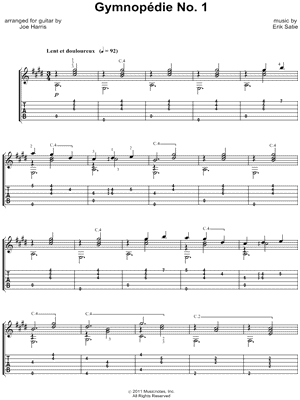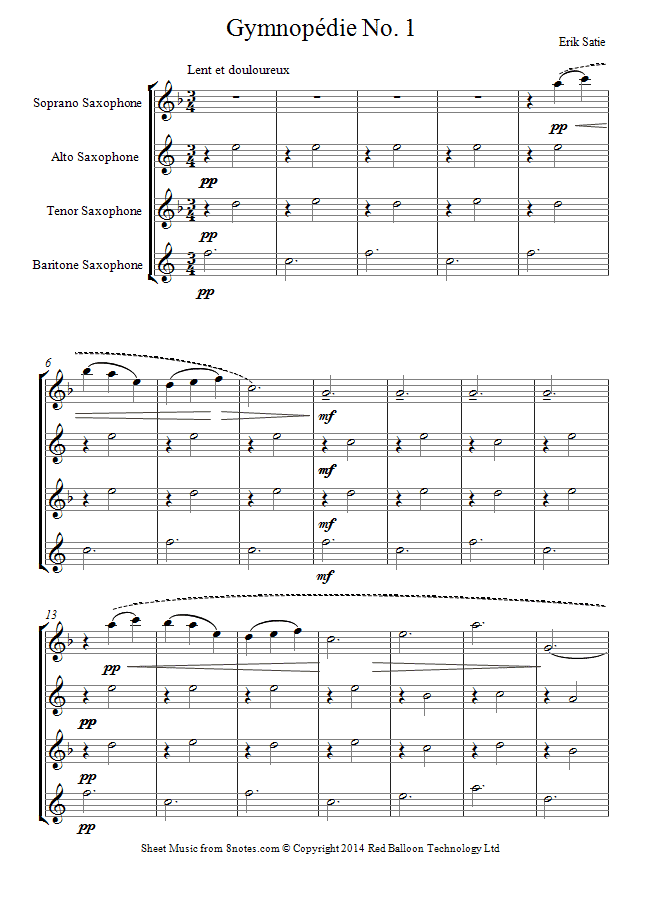Erik Satie Gymnopedie Guitar Pdf
More about how subscription works By clicking the Buy Now button above, you will first be asked to create an 8notes account if you don't already have one. Then you will be given the option of paying by either PayPal or by credit or debit card. If using Paypal, please note that payment is made out to Red Balloon Technology Ltd, the official owner of 8notes.com. Card payments use the Stripe.com payment system.
In both cases, all card information is handled securely by the payment processor and is not stored or seen by 8notes.com Your subscription lasts for 12 months from the date of purchase and you will be billed again in one year's time. You can of course cancel your subscription at any time if you do not wish to make any further payments. Paypal users should cancel from within their Paypal account.
Erik Satie Words & Music by Erik Satie arr. By John Kean Bm 7 Em 9 h = 88: 34 c k l g 1! B% & ' A D AA D A! Guitar Pro - Satie, Erik - Gymnopedie No.

If you pay by card you can cancel directly from your 8notes account. Simply click on the account menu and then the Subscriptions tab and look for the cancel link. Access should be instant after payment has been made in both cases. Before subscribing, please check our to ensure your will have no problems with our PDF files. Most common problems can be resolved on our. What subscription covers. All 8notes.com PDF files, all 8notes.com Subscription Only pieces What subscription doesn't cover.
Access to any in-copyright popular music, in particular, full versions of the popular music riffs. Refunds We have a no quibbles refund policy if you are unhappy with your subscription for any reason. Refund requests should be sent to. More about how subscription works By clicking the Buy Now button above, you will first be asked to create an 8notes account if you don't already have one. Then you will be given the option of paying by either PayPal or by credit or debit card. If using Paypal, please note that payment is made out to Red Balloon Technology Ltd, the official owner of 8notes.com. Card payments use the Stripe.com payment system.
In both cases, all card information is handled securely by the payment processor and is not stored or seen by 8notes.com Your subscription lasts for 12 months from the date of purchase and you will be billed again in one year's time. You can of course cancel your subscription at any time if you do not wish to make any further payments. Paypal users should cancel from within their Paypal account. If you pay by card you can cancel directly from your 8notes account. Simply click on the account menu and then the Subscriptions tab and look for the cancel link. Access should be instant after payment has been made in both cases. Before subscribing, please check our to ensure your will have no problems with our PDF files.
Most common problems can be resolved on our. What subscription covers. All 8notes.com PDF files, all 8notes.com Subscription Only pieces What subscription doesn't cover. Access to any in-copyright popular music, in particular, full versions of the popular music riffs.
Refunds We have a no quibbles refund policy if you are unhappy with your subscription for any reason. Refund requests should be sent to.
This was quite an easy arrangement to do. I compared the guitar version I found - which was far too simple and didn't take very good advantage of the idiom - with the piano score, and it only took Saturday and Sunday afternoons to get it done. Then, I did the fingerings and some revisions Monday and Tuesday, and I practically have the thing memorized already. When doing transcriptions of simple little pieces like this, I'm not afraid to take any and all liberties with the music.
Erik Satie Gymnopedie Wiki
First and foremost, I want to make the thing a guitar piece, and secondly, I want to make it my own. I view the printed sheet music in these cases as a recipe for making music: I season it to suit my own taste, and the requirements and resources of the guitar. So, while I doubt anyone familiar with this piece wouldn't recognize it immediately, the end result is quite different than the both the piano versions and the guitar arrangement that started this all. Here's the guitar arrangement I found while surfing the internet for guitar PDF files one night. I'd link to the original site, but I just don't remember where I found it. Measure six (Last measure, top stave) is an obvious impossibility, as it isn't possible to let the half-note D-sharp ring along with the attacked D-sharp on the last beat.
The attacked major second in measure seven doesn't sound very good either. The G-sharp in measure eight on the first beat is sustained in the piano score for four measures, but that doesn't work with the guitar's low level of sustain.
I don't think just abandoning it is a good solution, however. There is another impossibility in measure fourteen, and another attacked second in measure fifteen, both of which I eliminated in my version. More of these types of things follow. For some reason known only to the transcriber, in measure 34 he put the E and G-sharp accompaniment notes above the melody.
This is a particularly good example of something that just doesn't work, and isn't necessary. It is entirely possible to play those half notes down an octave below the melody, which is what I did. Measure 37 is entirely impossible to physically execute, so I had to come up with a better solution there as well. At 40 the piece returns to the top, so I don't know why Satie didn't just use a repeat mark and use a second ending, but 'oh well.' The only things different here are the last seven measures. Measure 76 is again impossible, and for the final chord he has an E major, where Satie wrote an E minor. Perhaps he did this because it is easier, but it totally ruins the effect Satie intended, so I corrected that.
Satie Gymnopedie Sheet Music Free
This is why I almost never do a 'transcription of a transcription' without consulting the original score. Here is the original piano score for comparison. D major is the original key, as you can see, and it is transposed to E major to take advantage of the guitar's open low E and A strings. It really does lend itself quite fortuitously to the guitar. In the third system you can see the sustained F-sharp (G-sharp in the guitar version). I simply re-attacked the note at the beginning of every measure, which is quite effective, making as it does alternating naked major sevenths and major ninths against the bass notes.
Since I untied the previous notes, I just made the strategic decision to do that wherever there were tied notes. I'm not trying to make the guitar sound like a piano, I'm trying to make this piece sound like it was written for the guitar.

This page is all repeated material. Here you can see the minor chord Satie actually ends with.
The only reason I knew the guitar transcription was wrong is because I have the recording of Christopher Parkening playing his version of this. Without that, I would have propagated the error if not for consulting the original score. Here's my transcription. The first five measures are unchanged, but in measure six I don't attack the D-sharp on the second beat. This is much more musically effective. In measure seven I not only don't attack the second on the second beat, but I was providentially able to use over-ring to let all three melodic notes sound (The D-sharp is played as a half note: I notated it as a quarter for simplicity's sake).
On the third stave you can see how I re-attack the G-sharp at the beginning of each measure, versus trying to let it ring (It won't; it'll die out) or abandoning it. Again, this is a far better solution for the guitar. The fourth stave is just a repeat of the second. In the last three measures of the fifth stave I again re-attack previously tied notes, as well as avoiding the weak sounding octave leap of the original transcription. The first two measures of the sixth stave I use the guitar's capacity for over-ring again, and in the last two measures there I beefed up the accompaniment chords with an additional D-natural an octave higher.
This creates a major second with the open E string, and it harkens back to the tactical over-ring device I'm employing. I reenforce this over-ring principle again in the second measure of the seventh stave, where I execute the D-natural as a half note. The end result is a very rich and colorful guitar piece that sounds positively lush and sensual. You can see in the third measure of the bottom stave where I lowered the accompaniment notes an octave to get them below the melody. The resulting C-sharp minor seventh chord on the second beat sounds nice and dense; much better than the other version. For the solution to the impossibility that was in the fifth measure of that stave before, I eliminated the C-sharp on the second beat, and then leapt up an octave in the bass for the final beat. It's not even that tricky to execute smoothly, and the two falling fifths in the bass line that follow are highly effective.
Erik Satie Guitar Tabs
Everything from the top of the page is a repeat until the bottom staff. Like I said, I'm not sure why Satie didn't just use a repeat and a second ending: I would have changed it if I could have comfortably fit everything on a single page, but I couldn't. There really isn't anything remarkable here, except for the fact that I end on a minor chord as Satie intended.
This worked out much better than I could have imagined, and I'll probably have the piece in my set in just a couple of weeks: It's that easy. And quite beautiful. Speaking of beautiful. I seriously want to tour eastern Europe! So many gorgeous girls there. Proudly awards this site as Recommended Reading Please vote for it in the! Alms for The Monk Study with Hucbald Hucbald Endorses: WHY MUSIC WORKS: The Harmonic Series, Musical Context, and the Laws of Musical Motion.
The Harmonic Series The Native Systems The Alpha Context Beta/Gamma Contexts Secondary Dominants Secondary Subdominants The Exotic Systems Exotic Motions Harmonic Canon The Alien Systems Alien Motions Mobius Loops The Extra-Diatonics Equal Temperament Integrated Chromatics The Ultimate Classic Guitar Arrangements Post Series Streaming Audio for All Pieces Sonata One in E Minor for Solo Classical Guitar by George Alton Pepper Streaming Audio for All Movements Musical Relativity Theory: Composing Counterpoint: Book Hucbald for a Gig: Need a solo guitarist in Texas? Outside of Texas/New Mexico? Monk's Music: PDF/MIDI/MP3.
Previous Posts.